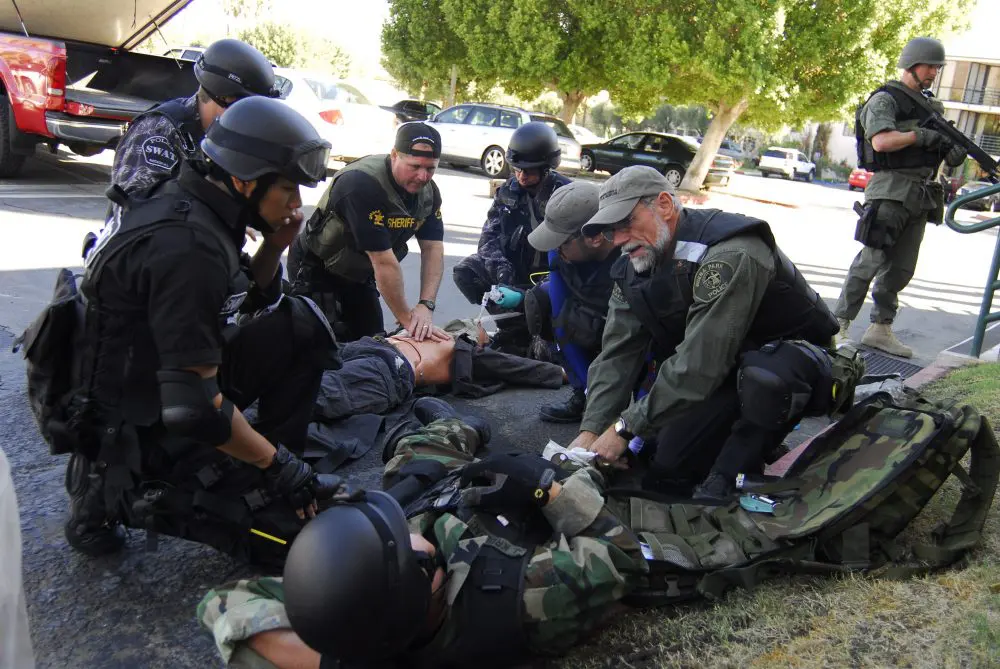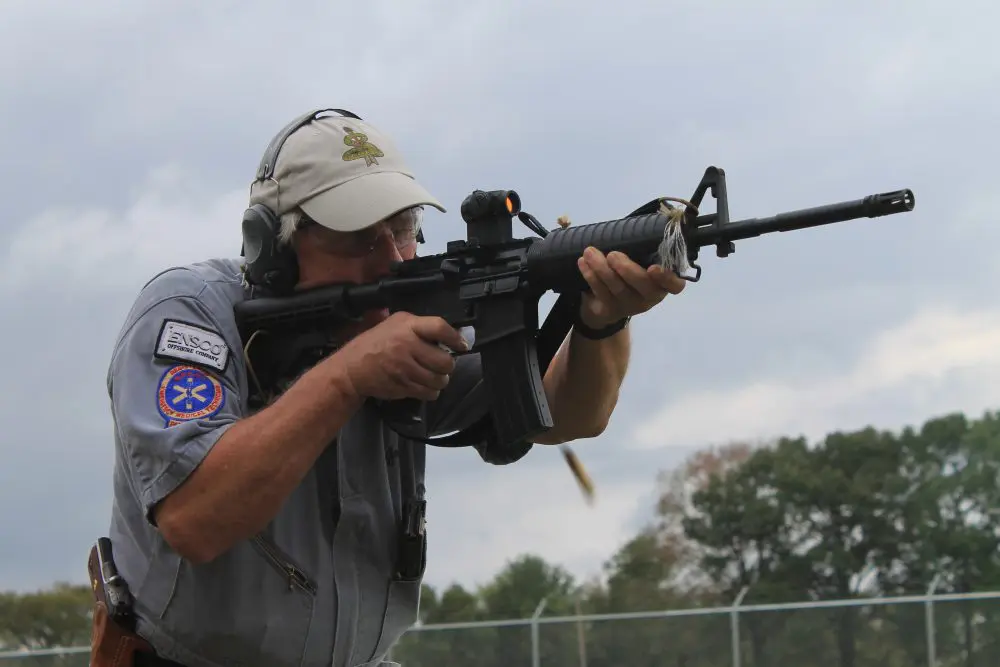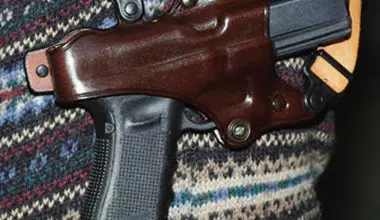For most compact cars and sedans, it generally means a reduced-size tire—a donut—that fits in the miniscule trunk and isn’t meant to go fast or far.
In the past, it was believed that iron sights were the only sights, the common thinking being that optics were too fragile. And this was correct. At that time, the majority of optics were hunting telescopes that were absolutely too fragile for tactical use.
However, that was then, and this is now. The state of the art in weapons, mission- essential equipment that is mounted on weapons, and how these weapons are used have all changed.
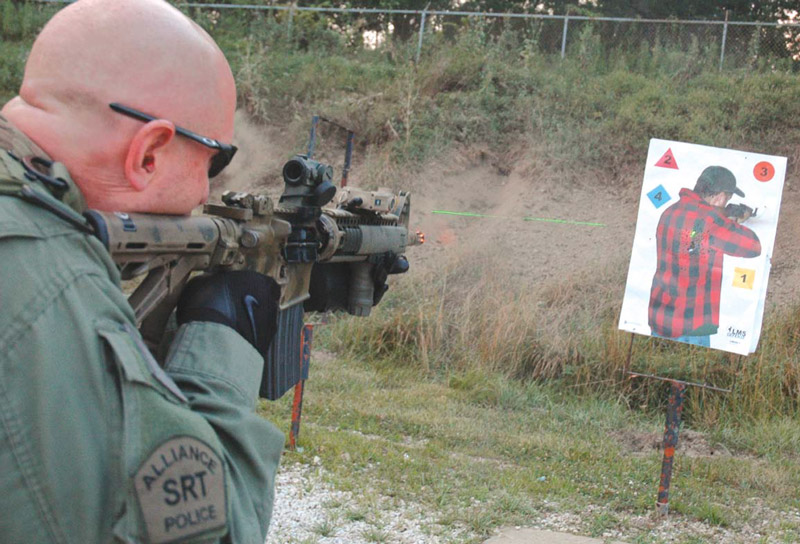
Table of Contents
OPTICAL SIGHTS
Optical sights—other than telescopes used on precision rifles—have been used by the military going back to at least 1970. And as these optics have evolved (albeit slowly), they have become more than just common. Red Dot Sights (RDS) are prolific in the military because they have great usefulness within the envelope that most infantry combat occurs, and has occurred, for the past century.
Telescopes, both fixed and variable power, can extend the range at which targets can be identified and engaged. However, many users fail to understand that telescopes do not help you shoot better. They help you see better, but without applying the basics, all you wind up with are misses at greater distance.
Certainly the optics now in general use in the military are sufficiently rugged for the mission, and as time marches inexorably on, we will see even more capable sights coming through the pipeline.
Nothing, however, is perfect, and failures in optics can occur, much like failures in weapons, ammunition, computers, parenting or critical thinking skills.
We live in an imperfect world. Deal with it.
To that end, most combat rifles that utilize an optic as a primary sight will also have an auxiliary sight, commonly known as a Back Up Iron Sight (BUIS). The idea was that, in case of an optical sight failure, one could use the iron sights to continue the fight.
This is known as a good thing, but it is not without issues. Understand that not all back-up sights are “iron.” In fact none are iron, but that is a legacy term from days of yore, so it generally means metal: steel or aluminum. The Magpul MBUS is a polymer back-up sight, but generally speaking, BUIS is a generic term, much like “Piper Cub” is used to describe all aircraft with a single fan in the front.
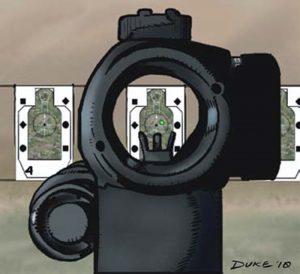
FOLDING AND FIXED BUIS
The issues are these. There are two types of BUIS: folding and fixed.
The folding BUIS requires you to erect the unit in the event of RDS failure. The upside is that it leaves the viewing plane of the primary sight clear and uncluttered.
The fixed BUIS does not require any additional action to use. However, it does clutter the primary sight.
I strongly prefer the folding BUIS because I like the clear view of the sight that is in almost constant use. I last had an Aimpoint go down in 1996, so (besides zeroing) I don’t often use the BUIS.
Note: if you have an RDS that often goes down, has poor battery life or is otherwise non-functional, consider a change in your primary optic.
At close range, the BUIS is not necessary, as you can use the down optic as a large ghost ring sight. At distance, you will likely have time to erect it.
The overarching issue is that the iron sights are less capable than the optics. Yes, I know, iron sights never break, are more accurate, are always there and so forth.
Nonsense. Iron sights are durable, but we have seen enough breakage to understand that nothing is infallible. More accurate? Maybe, and under certain conditions— bright light, shooting across golf courses, unlimited time and good eyesight—sure.
They also require you to shift your focus from the bad guy while concentrating on the front sight, which is centered in that rear sight aperture while he, you or both are moving—hopefully in daylight.
See the problem?
Gunfights often take place in dim or low light, in areas where you can’t get into a “legal” shooting position, and involve multiple targets.
While some RDSs have excellent reliability and spectacular battery life, nothing made by man is going to work all the time, every time.
But having to go from a very capable sight (an RDS) to a much less capable legacy sight (an iron sight) is a step backwards.
While Luddites can argue that the iron sights never break, etc, optical sights would not have reached supremacy if irons were better.
That is a simple fact of life, and to ignore it is to embrace stupidity.
So, back to the problem at hand. Why go from a very capable primary sight to a less capable legacy sight in the middle of a gunfight?
The short answer is, we don’t.
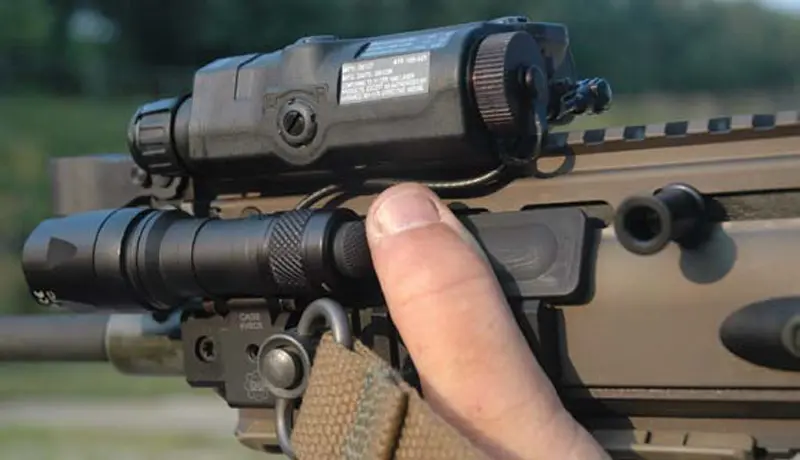
AIMING LASERS
Aiming lasers have been around for a while, although the visible lasers have too often been an answer looking for a question. However the Global War on Terror has provided us with a plethora of solutions to the killing of bad guys.
In the not-so-recent past, infrared aiming lasers existed for the M4 family of weapons (FOW) in the form of the legacy AN/PAQ-4C and the AN-PEQ-2A. Both of these are out of production though are still seen in the hands of some.
It wasn’t until the introduction of the Multi Function Aiming Laser (MFAL) that we started to see enhanced capabilities. The MFAL provides an IR aiming laser, an IR illuminator and a visible laser.
In the MFAL, the visible aiming laser is slaved to the IR laser. This means that you can zero the IR laser during the day and should only have to verify at night. This is a major plus, and the aggravation of getting a zero on the PEQ-2A is tucked away in the bad memory locker.
The visible laser is useful for a variety of tasks, to include marking targets for others (much better than yelling “Third window from the left, Dan! No, the other left!”) as well as for training.
When I first started running the Laser Devices DBAL-A2 a few years back, I experimented with it as a substitute for BUIS. Others whose opinions I trust reported good results and I accelerated the process.
My verdict on the visible laser, based on use in daylight and low light, is that it is a better option than the BUIS. (“Heresy!” scream the followers of Ned.)
VISIBLE LASER: PROS AND CONS
As with everything in life, there is no free lunch, so let’s look at the pros and cons of the visible (vis) laser.
PRO
- Intuitive. You replace the red dot with a red (or green) dot.
- Switchology. If the switchology is properly set up, the vis laser is faster than erecting a rear BUIS.
- More efficient. The visible dot on the target means that you can focus on the threat and superimpose the dot on it— no centering the front sight tip in the rear sight aperture.
- No compromising the primary optic. If you use a non-folding rear BUIS, you are blocking the view through the primary optic.
CON
- Significantly more expensive. An MFAL costs approximately $3,000. A straight visible laser will be much less expensive, but still a lot more than a $125 BUIS. Then again, what is your life worth?
- Battery life. For the MFALs, battery life at the continuous setting is approximately five hours. That translates into scores of engagements. You do the math.
- Not all vis lasers are the same. As with guns, there is no such thing as “as good as.” It is good, or it sucks. Period.
DON’T FORGET TO SWITCH ON YOUR BRAIN
Depending on the unit you have, the distance at which you can see the dot depends on the power of the unit, the color of the laser, and ambient lighting conditions.
Realistically, a red laser in bright daylight may be visible at 25 yards. A green laser may be visible under the same conditions at 100 yards (at Great Falls, Montana, recently I had no problem seeing the green laser on my DBAL-A2 at 384 yards under overcast skies).
You have to be smarter than your equipment. This means you have to set the laser unit in the proper location on your carbine, and be able to manipulate the proper switch at the proper time. After mindset and having the right equipment, the location of the switches is critical.
I am satisfied with how I have configured my guns, having used this particular set-up on several carbines for years. Your grip, stance and mission-essential equipment may of course vary. At EAG Tactical, we run AN/PEQ-15As (aka DBAL-A2s) on our guns. However, if you run an MFAL or visible laser that accepts a pressure pad switch, this may work for you.
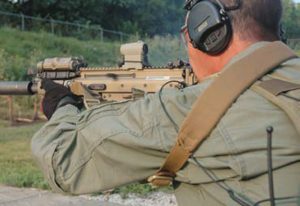
WHITE LIGHTS
Understand as well that a white light in most cases is a necessity, not an option. There are several white lights that are purpose-built weaponlights, made by a number of companies. As with all else, some of the lights are good and some suck, with few falling in the middle.
The purposes of the white light are to identify threats and assist me in placing projectiles inside said threats. The white light is not a weapon—it is an illumination tool that enhances the ability of the shooter to defeat the threat. My preference is for the white light to be on the non-dominant side, which for me is the left side. I run the white light at 10:30, so that it tucks in close to the rail.
We have a number of different lights, the most common being the SureFire G2, with the Scout/Mini Scout and Laser Devices OV-2 and OV-3 lights in limited numbers. We keep them in either the Viking Tactics VTAC Mount or the excellent DangerClose Mount. Each keeps the light in close to the rail.
I run a click on/off tail cap on the white light. I do not ever want a tape switch on the white light for a variety of reasons, to include having watched a Canadian buttload of white light NDs as well as needing to keep the white light on when my non-dominant hand is off the gun.
SWITCHOLOGY
I use a stubby VFG with my thumb on the left side of the gun. It rests naturally on the back end of the light. I do not have to make any drastic movements of my hand to activate/deactivate the white light.
I run a pressure switch for my MFAL, which makes sense for that unit. I attach that switch to the rail at 9 o’clock, which allows me to activate it with the heel of my left hand.
The switchology is intuitive and does not require me to move my hand to operate either device.
I leave the visible laser lens cover off and the switch on low power. In the rare event that the red dot goes down, all I need to do is apply slightly more pressure with the heel of my support-side hand. The red dot is now replaced by a green one.
Understand that practice does not make perfect—it only makes permanent. In this case, this system works in our favor. We run that RDS daily, and its ease and efficiency are ingrained into our system.
That’s it. Nothing else….
KEEPING IT SIMPLE
Here is what makes this system so simple. You have been shooting that red dot sight (RDS) for a fair amount of time. During that time, you have developed what is sometimes called “muscle memory,” which allows you to perform the act of getting the gun on target at the speed necessary to defeat the threat.
In order to do this at the speed required, you must understand that you are looking through the RDS. It’s just that now, instead of looking at the reticle generated within the sight, you are looking at a laser dot mounted on the rail of your carbine.
Your eye can barely tell the difference between the RDS reticle and your laser when it is viewed through the RDS.
Visible lasers got a bad rap (and rep) because people were attempting to aim their weapon with the laser while using a non-standard position (for example, an underarm position or looking over the gun to see the laser).
If you are seeing the dot and then trying to move it onto the target, you will be considerably slower than if you were mounting the rifle like you would with the RDS.
Pretty simple, actually.
A caveat is necessary, at least from my point of view. There are a great number of lasers being made, and obviously the visible laser only units are more prolific and less expensive than the MFAL. However, some of these sights are in vertical foregrip-type mounts, which can severely limit your shooting style as well as integration with other systems.
The laser, no matter visible or infrared, is best mounted on the rail close to the bore centerline.
EFFICIENT OR INEFFICIENT—YOUR CHOICE
Conventional BUIS will continue to be placed on rifles, though they are seldom used (I last used mine circa 1996). They are inexpensive and lightweight, and while they are (relatively) inefficient, the compromise is acceptable for most. This is especially true for those whose mission requirements do not include night vision. However, bypassing an inefficient sighting system and using a more efficient one to engage people whom you are trying to kill can be construed as a Very Good Thing.
Determine exactly what your mission is and get the very best gear that will contribute to mission success. Get the very best training that you can afford.
And when you finish, train some more.
